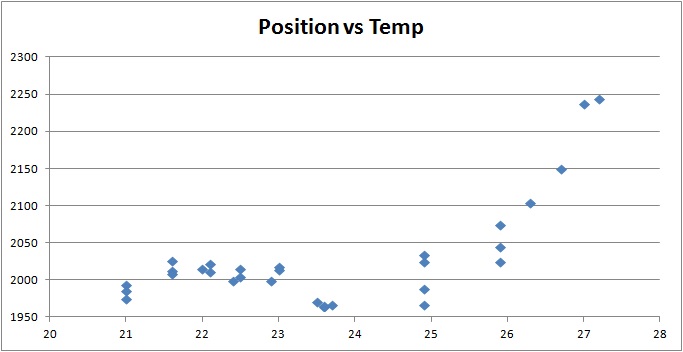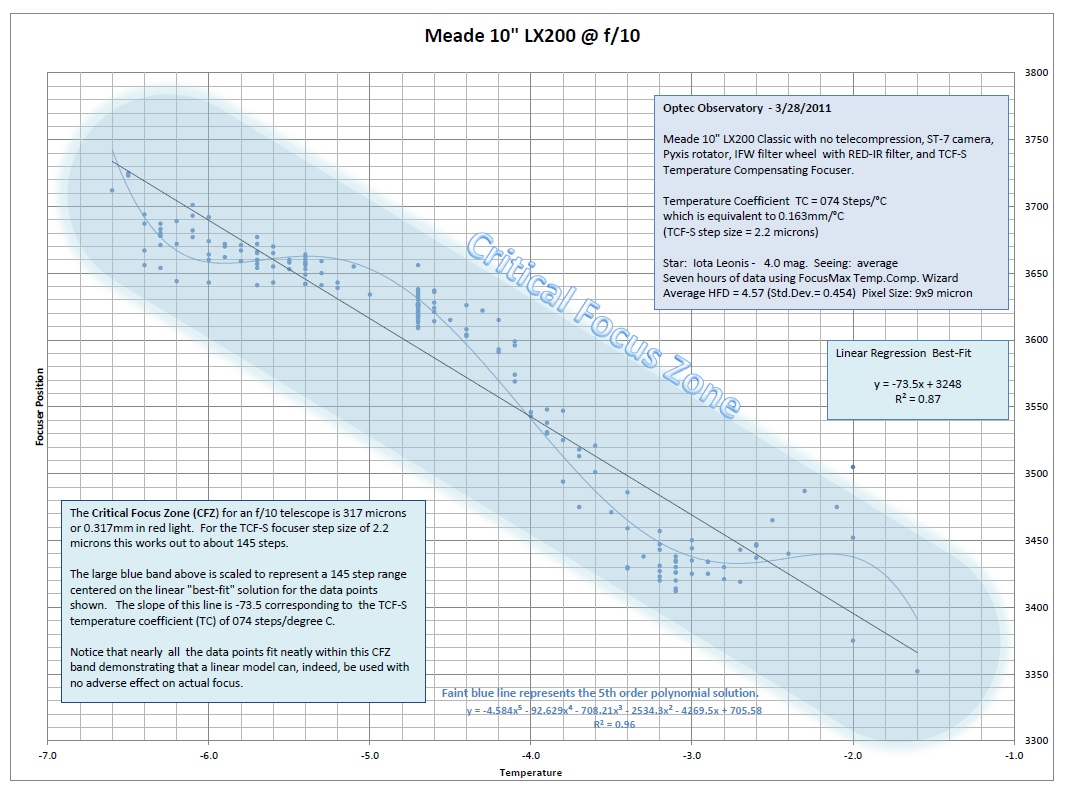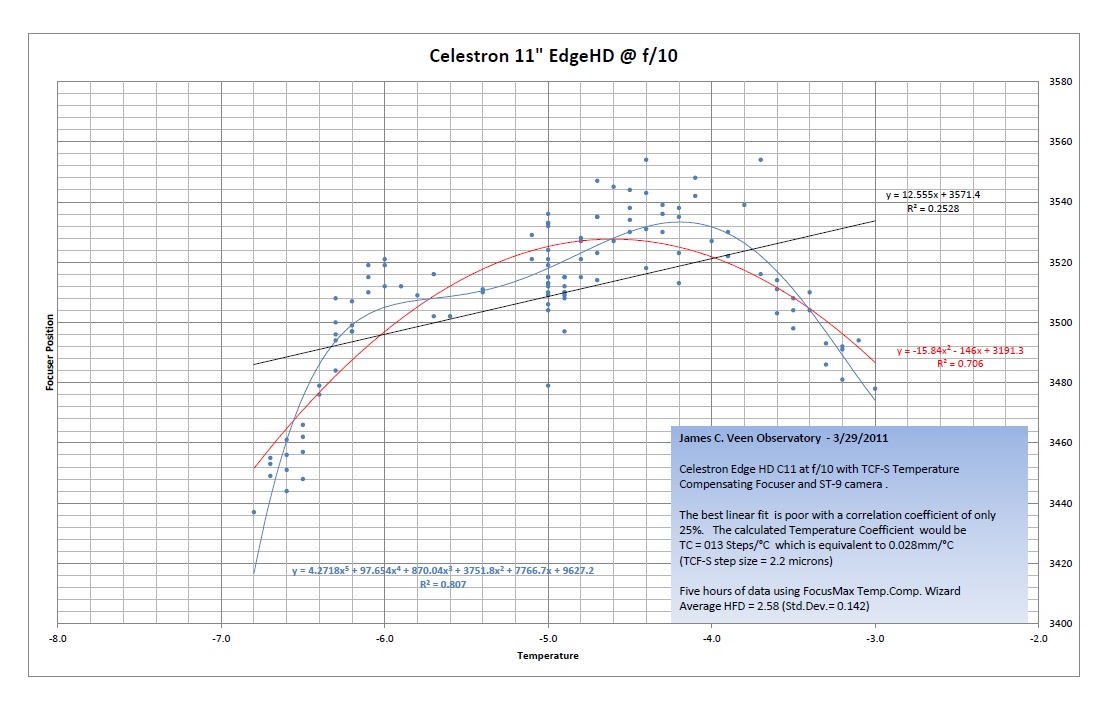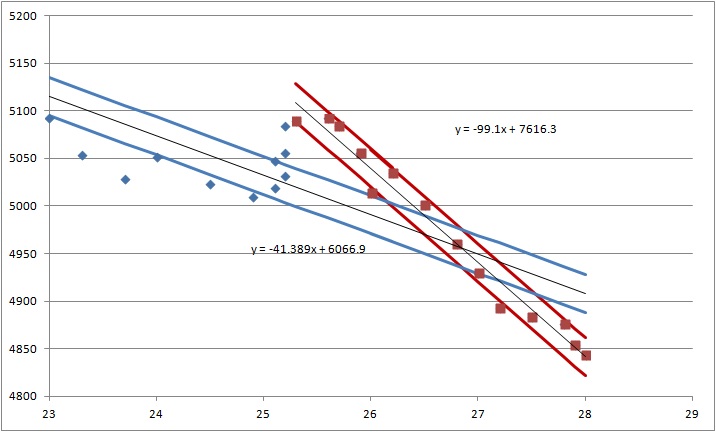As part of my plan to use the Edge as the guider for the Tak, I worry that the Edge will get out of focus as the night goes on. The main imager gets focused regularly through ACP, but the guider does not get focused. The Tak holds focus pretty well, but the Edge has bigger fluctuations, I think. Unfortunately, it is a pain to switch FM and Maxim over to focusing the Edge, do the focus, then switch everything back again.
Solution? Maybe I should finally get the temperature compensation working in the Optec (on the Edge). Maybe this would keep the Edge in better focus over the night. Supposedly slightly out of focus is better for guiding, anyway. I suspect that does not apply to large donuts like I was getting after awhile.
To check this out, I first gathered some data manually using my standard settings (NearHFD 15, 5 steps in 5 samples). I collected data every 30-60 minutes, doing several FM runs at each time to see how the data spreads. The results are shown:

OK, this looks weird. I am expecting a linear response – it Looks like I get this for awhile, then the temperature levels out?
Jeff Dickerman’s Data
Some discussion on FM Users Group provided some very nice data from Jeff Dickerman, who I believe is with Optec. He has looked at a Meade, which shows the expected linear relationship:

Note the blue area, indicating the size of the New Critical Zone.
He also looked at the Edge 11, same setup as I have:

Jeff’s conclusion was not to even use temperature compensation on the Edge. The effect is small (11 steps per degree compared to the Meade 75 steps so he just refocuses every so often. Note that on the Meade, he still refocuses – he just does it every 120 minutes instead of every 60.
Second Try
Reading a Steve Brady presentation at AIC, it looks like I need to tighten up some of my focusing parameters. For example, I know the NearHFD setting needs to be on the flat part of the VCurve. I had mine set at 15; that already “seemed” high, because the Tak has smaller HFD values in general. After some testing, it looks like 25 is a better value. I also changed the convergence criteria to be 3 steps in 5 samples; Steve had shown using 2 steps, which I worry might be too tight? Using the value of 3 steps, serial focus runs are doing a better job being consistent. I need to look at the Tak settings as well:)
Note: my New Critical Focus Zone is 36.7 steps on the Optec, according to something I read (Wodanski, I think).
CFZ = 1.6 lambda f^2
= 1.6 * 500 * 10^2 = 80 microns
For Optec, 7000 steps/0.6 inch? ==> 36.7 steps
I assume this means that my “blue zone” on a graph like Jeff’s would be about 20 steps above and below the trend line.
OK, now to collect some better data! FocusMax has a nice Wizard function that is supposed to help gather this data automatically, rather than doing everything manually. Of course, the Wizard doesn’t seem to get enabled in FM! Started a thread on FM Users group, and Steve kindly made an updated version (3.8.0.15) which now works.
Here is my second cut at data, collected using the FM Temperature Compensation Wizard. Data points are collected every 10 minutes. I am using my tighter convergence settings.

Well, I again see a weird shape. The shape is not at all the same as what I collected manually! In the beginning the slope is negative, as seen in Jeff’s data. My first try had a positive slope! Both nights started out fairly warm, around 28 degrees C.
The initial slope shows 99 steps per degree, while the total data is 41 steps per degree. The flat portion might be 20? I didn’t fit that section. During the linear portion the focus results fit within my CFZ; clearly the overall data does not.
So, what is going on? I wonder if this has to do with the sealed baffle tube with the Edge’s corrector optics. Maybe the flat section has to do with the two tubes becoming closer in temperature? At first the main tube is cooling (like the Meade), then eventually the sealed nature of the Edge leads to the flatter section.
I would like to rerun this using some kind of fans blowing into (out of?) the Edge vents. Deep Space Products produces these fans to help equilibrate the tube. I would like to try some simply approach before spending the $165. If fans lead to a linear result, maybe compensation makes sense. Otherwise, Jeff is right – forget it, just do regular focusing.
